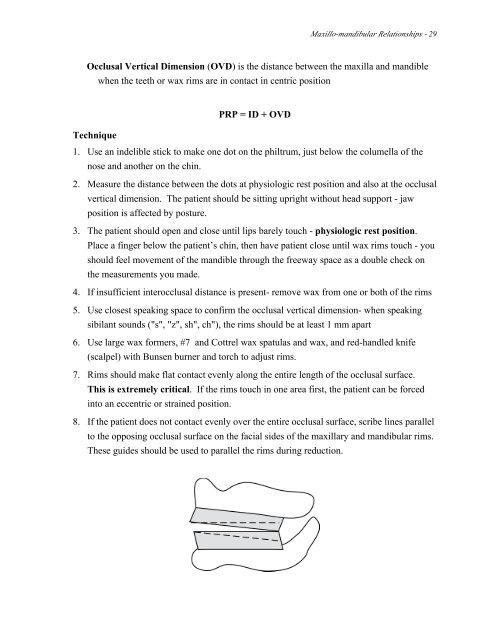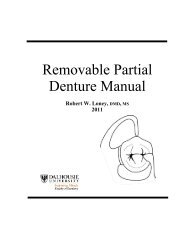Manuals_files/CD Manual 12.pdf - Removable Prosthodontics
Manuals_files/CD Manual 12.pdf - Removable Prosthodontics
Manuals_files/CD Manual 12.pdf - Removable Prosthodontics
You also want an ePaper? Increase the reach of your titles
YUMPU automatically turns print PDFs into web optimized ePapers that Google loves.
Maxillo-mandibular Relationships - 29<br />
Occlusal Vertical Dimension (OVD) is the distance between the maxilla and mandible<br />
when the teeth or wax rims are in contact in centric position<br />
PRP = ID + OVD<br />
Technique<br />
1. Use an indelible stick to make one dot on the philtrum, just below the columella of the<br />
nose and another on the chin.<br />
2. Measure the distance between the dots at physiologic rest position and also at the occlusal<br />
vertical dimension. The patient should be sitting upright without head support - jaw<br />
position is affected by posture.<br />
3. The patient should open and close until lips barely touch - physiologic rest position.<br />
Place a finger below the patient’s chin, then have patient close until wax rims touch - you<br />
should feel movement of the mandible through the freeway space as a double check on<br />
the measurements you made.<br />
4. If insufficient interocclusal distance is present- remove wax from one or both of the rims<br />
5. Use closest speaking space to confirm the occlusal vertical dimension- when speaking<br />
sibilant sounds ("s", "z", sh", ch"), the rims should be at least 1 mm apart<br />
6. Use large wax formers, #7 and Cottrel wax spatulas and wax, and red-handled knife<br />
(scalpel) with Bunsen burner and torch to adjust rims.<br />
7. Rims should make flat contact evenly along the entire length of the occlusal surface.<br />
This is extremely critical. If the rims touch in one area first, the patient can be forced<br />
into an eccentric or strained position.<br />
8. If the patient does not contact evenly over the entire occlusal surface, scribe lines parallel<br />
to the opposing occlusal surface on the facial sides of the maxillary and mandibular rims.<br />
These guides should be used to parallel the rims during reduction.















